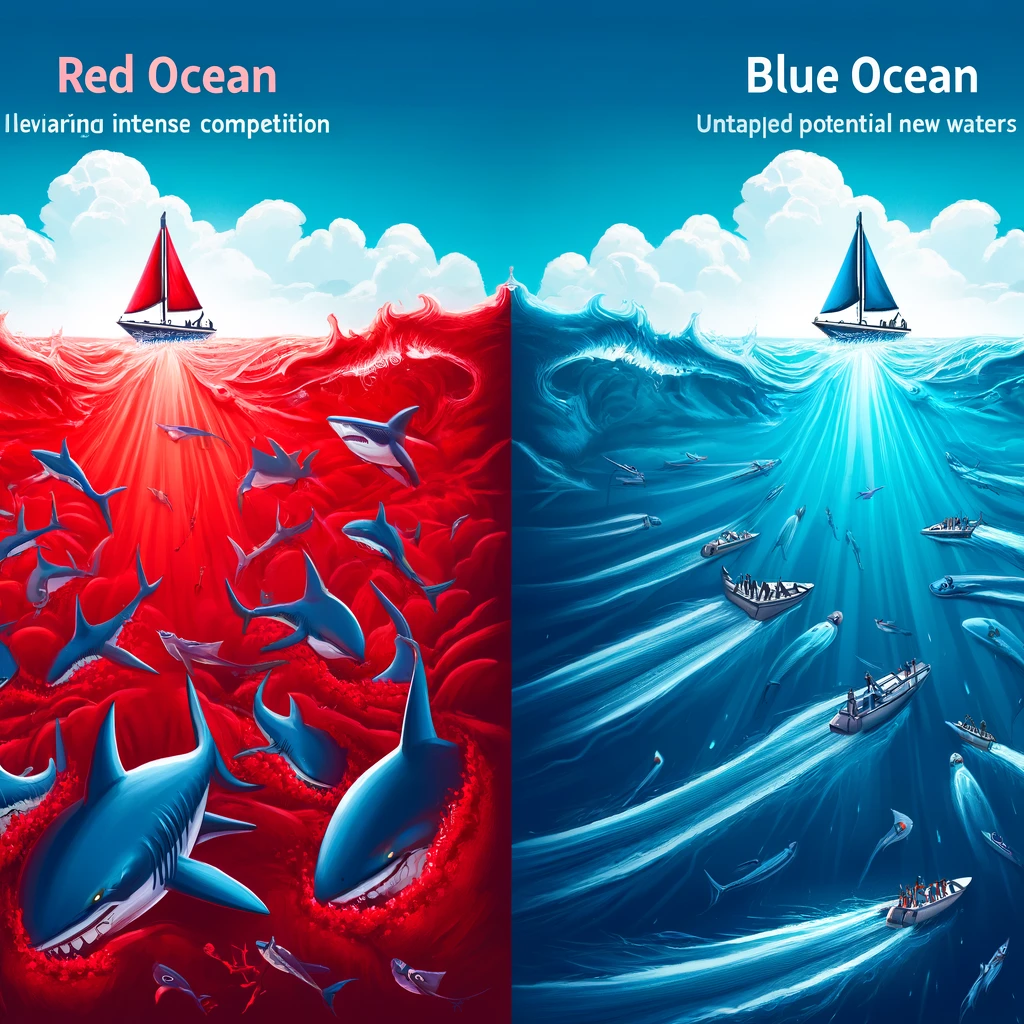1. Introduction
In the competitive world of business, choosing the right strategy can significantly impact your sales. Imagine navigating through two distinct seas: one filled with fierce competition and the other offering untapped potential. These are the Red Ocean and Blue Ocean strategies. Understanding these concepts is crucial for businesses aiming to maximize their sales and growth. Let’s dive into the depths of these strategies and help you decide the best course for your business.
2. Understanding Red Ocean Strategy
Definition and Core Principles: Red Ocean strategy revolves around competing in existing market spaces where the competition is fierce. The primary goal is to outperform rivals and capture a larger share of the current demand.
Characteristics of Red Ocean Markets:
- Intense Competition: Multiple players vying for market share.
- Established Demand: Proven market with existing customer base.
- Value-Cost Trade-Off: Businesses either differentiate themselves or reduce costs to gain an edge.
How Competing in Existing Markets Can Increase Sales:
- Leveraging Proven Demand: Tapping into an established customer base allows for predictable sales opportunities.
- Benchmarking Competitors: Learning from competitors’ successes and failures can inform your sales strategies.
- Clear Metrics for Success: Established markets provide clear benchmarks for measuring success and performance.
Example: Competing in the crowded SEO tools market by offering more comprehensive packages or better customer support than giants like SEMrush or HubSpot can help capture a significant share of an already proven market.
3. Exploring Blue Ocean Strategy
Definition and Core Principles: Blue Ocean strategy focuses on creating new market spaces or redefining existing ones, making the competition irrelevant through innovation.
Characteristics of Blue Ocean Markets:
- New Market Creation: Opens up new demand and opportunities.
- Competition Irrelevance: Focuses on innovation, not competition.
- Value Innovation: Achieves differentiation and low cost simultaneously.
How Creating New Markets Can Drive Sales Growth:
- High Growth Potential: Less competition means more room for rapid growth.
- Establishing Market Leadership: Being the first mover in a new market can secure long-term customer loyalty.
- Addressing Unmet Needs: Fulfilling unique customer needs that competitors have overlooked can drive significant sales.
Example: Developing AI tools for niche industries, such as AI-driven personalization for small businesses, can create a new market with minimal competition and high demand, leading to substantial sales growth.
4. Comparing Red Ocean vs Blue Ocean Strategies

Key Differences:
- Red Ocean: Competes in existing markets, focuses on outperforming rivals.
- Blue Ocean: Creates new markets, focuses on innovation and making competition irrelevant.
Examples of Successful Companies Using Red Ocean Strategies:
- Competing in the highly competitive social media management tools market by offering unique features or better pricing.
Examples of Successful Companies Using Blue Ocean Strategies:
- Introducing a new AI tool that offers hyper-personalized marketing solutions for small businesses, a segment previously overlooked by larger players.
5. Decision Factors for Your Business
Market Analysis:
- Red Ocean: Assess market size, growth rate, and competition intensity. Understand customer needs and existing solutions.
- Blue Ocean: Identify gaps in the market or areas with low competition but potential demand. Consider future trends and technological advancements.
Resource Availability:
- Red Ocean: Ensure you have the resources to compete on features, price, and marketing.
- Blue Ocean: Be prepared to invest in innovation, market education, and customer acquisition strategies.
Risk Appetite:
- Red Ocean: Lower risk with steady rewards.
- Blue Ocean: Higher risk but the potential for substantial rewards.
Business Goals:
- Red Ocean: Prioritize short-term gains and quick market entry.
- Blue Ocean: Focus on long-term growth and unique market positioning.
6. Case Studies
Red Ocean Case Study: Competing in the SEO Tools Market
- Overview: Established players like SEMrush, Ahrefs, and Moz dominate this market.
- Strategy: Differentiate by offering unique features, superior customer support, or competitive pricing.
- Outcome: Increased market share and sales through effective differentiation.
Blue Ocean Case Study: Innovating with AI-Driven Personalization Tools
- Overview: Identifying unmet needs in the small business segment.
- Strategy: Develop AI tools that offer personalized marketing solutions, educating the market on the benefits and capturing new demand.
- Outcome: Rapid sales growth and market leadership in a new niche.
7. Implementing the Right Strategy for Sales Growth
Steps for Adopting a Red Ocean Strategy to Boost Sales:
- Analyze the Competition: Understand what your competitors are doing well and where they fall short.
- Differentiate Your Offerings: Focus on unique features or superior customer service.
- Optimize Pricing: Ensure your pricing is competitive without compromising on quality.
- Enhance Marketing Efforts: Use targeted campaigns to capture market share.
Steps for Adopting a Blue Ocean Strategy to Drive Sales Growth:
- Identify Unmet Needs: Research potential gaps in the market that competitors have overlooked.
- Innovate: Develop unique solutions that address these unmet needs.
- Educate the Market: Invest in marketing to inform potential customers about your new offerings.
- Monitor and Adapt: Continuously track performance and adjust strategies based on feedback and market changes.
Hybrid Approach: Combining Both Strategies for Maximum Sales Impact:
- Stability and Innovation: Secure a position in established markets while exploring new opportunities.
- Balanced Growth: Achieve short-term gains and long-term growth.
Example: While offering competitive SEO tools, simultaneously develop AI-driven solutions for emerging markets, ensuring a balance of stability and innovation.
8. Conclusion
Choosing between Red Ocean and Blue Ocean strategies depends on your business goals, resources, and risk tolerance. A thorough analysis of your capabilities and market conditions can help you align your strategy with your long-term vision. Balancing both strategies can provide a comprehensive approach to achieving sustainable growth and market leadership.
For more in-depth insights and frameworks, consider reading “Blue Ocean Strategy” by W. Chan Kim and Renée Mauborgne. It’s a treasure trove of case studies and practical advice for creating and capturing new market spaces.
9. Call to Action
Ready to take your digital marketing and AI tools to the next level? Contact Digital Marketing Helpline for expert advice and innovative strategies. Subscribe to our newsletter for the latest tips and insights, and explore our other blog posts to continue your learning journey.

